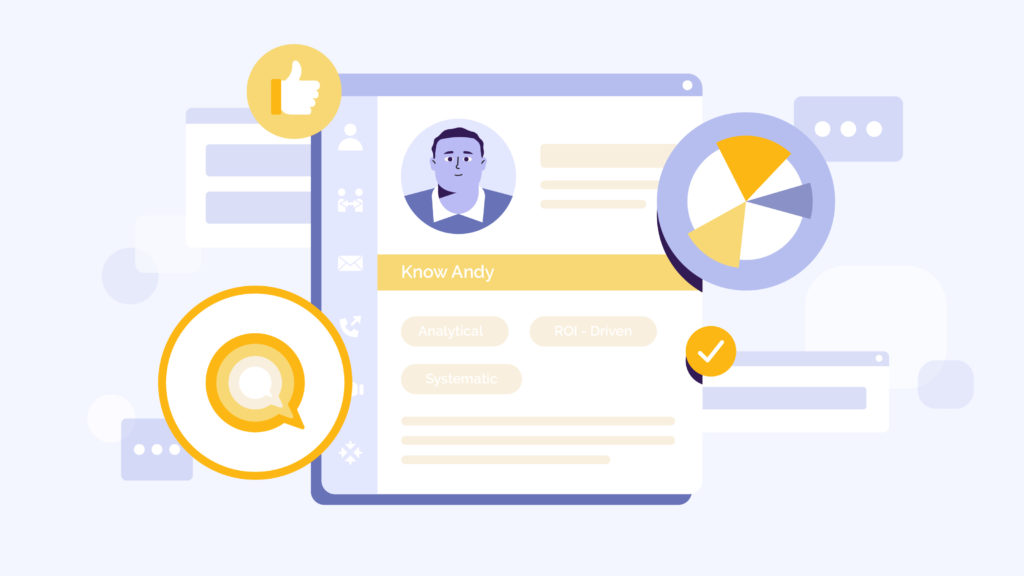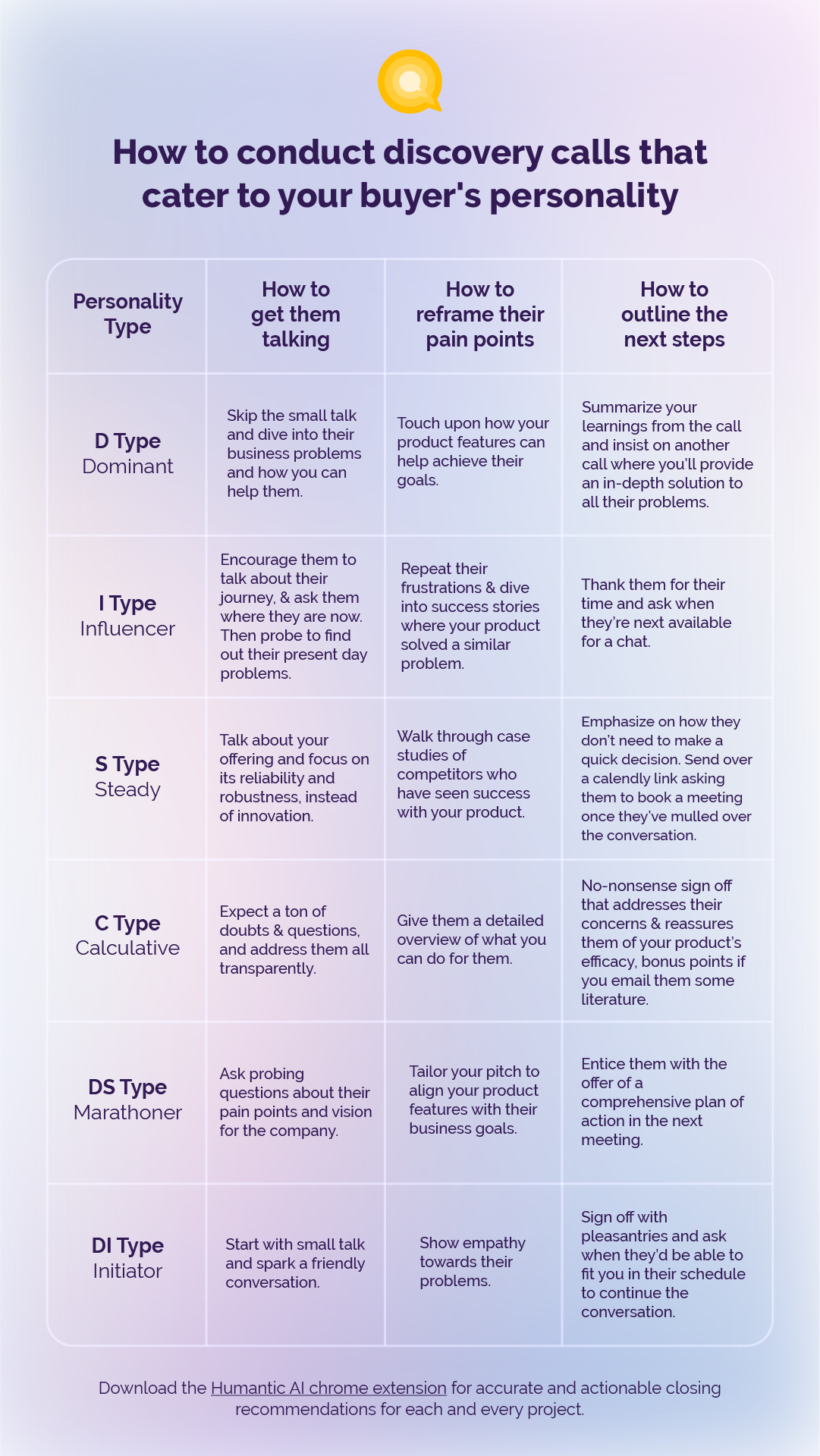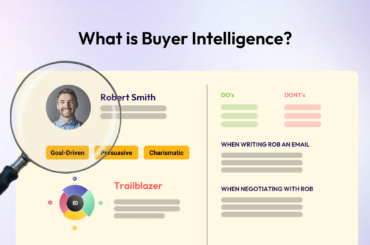Here’s a universal truth in sales if there was ever one: discovery calls are daunting. Your prospect puts forth a sales objection and more often than not, you falter. Then they sense your uncertainty and swoop in with a big, resounding NO. You could risk losing opportunities before they even become one.
Don’t worry. It happens to the best of us. And I’m here to give you a solution.
This isn’t your run-of-the-mill “X things you need to know article.” Get ready for some pretty powerful stuff. It all begins with one golden rule—learn who your buyers are. Inside and out.
Understand their core motivations, frustrations and desires. You can then tailor your pitch accordingly. But getting a read on your prospect isn’t as easy when they’re not willing to open up about the challenges they’re facing. If they don’t communicate, you don’t get the information you need to nudge them across the sales pipeline.
So, how do you get your prospects talking on a discovery call? We’ve got a foolproof strategy that can work wonders. Let’s dive in.
Nailing a discovery call with personality insights
You’ve successfully booked a meeting with your prospect. With half an hour left before the call starts, you realize you know zilch about them. What do you do?
If your first instinct is to look up the company’s website, you’re barking up the wrong tree. Remember: You’re not selling to the company. You’re selling to a person hunting for a solution. To build rapport with them, you need to first gain an insight into their individual personality, not the company they work for.
Now, the million dollar question is, how do you find these elusive insights? Look no further than Humantic’s Personality AI Assistant. Simply go to your prospect’s Linkedin profile and let the assistant work its magic. In 30 seconds flat, you’ll have in-depth information on what makes your prospect tick. This can act as a guide to your discovery call. Before we show you how, let’s brush up on the basics.
What makes a successful discovery call: A recap
Here’s a quick refresher on best practices you should follow during a discovery call to gain trust and traction for your product:
Put on your journalist cap
While talking to your prospect, put yourself in the shoes of a journalist. Conduct some background research on them, analyze their areas of interest and frame the right open-ended questions to keep them talking.
Don’t get too salesy
Be subtle. This approach will work wonders because instead of raving about your product, you’ll be talking about the value it can add to your prospect’s company. By twisting the knife on your buyer’s pain points, they’re more likely to have a positive attitude towards your pitch.
Repeat their problems
Towards the end of your discovery call, repeat everything you’ve learnt about your prospect’s pain points. Ask them if there’s anything they’d like to add. This prevents communication gaps.
Get their attention
Show them how your sales offering will provide them with a solution personalized to their needs. But don’t give away everything right now, outline the next steps—whether it’s booking another call, sharing resources or conducting a demo.
Example 1: Meet Anthony Iannarino, The Marathoner
So, I need to sell a product and Anthony is my first prospect. He has agreed to a quick tête-à-tête with me. As a renowned Sales Leader, he probably knows every sales technique in the book. Nevertheless, I charge forward with the conversation and take the lead. I explain how each feature in my product can improve business productivity. He patiently listens.
But just as I move in to ask about his business pain points, he tells me he’s got another meeting to attend and leaves the call. What on earth happened? Let’s run Anthony’s profile through the Humantic Personality AI Assistant to see what went wrong.

At first glance, you may think my approach was on-point. Humantic’s personality insights says Anthony is result-oriented. That means he’d want to know how exactly my product will help him, right?
Truth be told, it doesn’t really work that way. Although I did some basic research on Anthony’s personality, I didn’t cover all my bases. In the process, I forgot to account for his DISC type.
According to Humantic, he is a Marathoner (DS-type). This means although he’s focused on getting good results, these improvements need to be in alignment with his business needs. Anthony isn’t interested in knowing how my product helps businesses. Rather, his concern is how it’s aligned to the big picture.
Now imagine Anthony gives me a second shot at the discovery call (after a tonne of follow-ups, of course). How can I improve my strategy, keeping in mind he’s a DS-type?
My first move would be to steer the conversation towards his goals. Instead of starting the conversation with product features, I’d lead with common business challenges and ask if his company faces any of them. This will encourage him to speak about his vision and the obstacles slowing his progress towards it.
I could then use this information to pin-point which of my product’s features could solve his problems and fast-track his business plan. DS-types tend to think long-term. They don’t pay attention to the nitty-gritties. So, if your prospect is a marathoner, zero in on their pain point and address it off the bat.
| Prospect | How to get them talking | How to reframe their pain points | How to outline next steps |
| Anthony (DS-type) | Ask them about their vision for the company and what’s stopping them from realizing it | Explain how your product addresses their specific business challenges | Be direct. Quickly summarize their goals and reiterate how you can help. All they need to do is book another meeting with you for a clearer picture. |
Example 2: If Anthony was a DI type
Now, let’s say your prospect is an Initiator (DI-type). You’ll need to handle things a bit differently. Instead of getting straight to the point, you’ll need to spend some time building rapport with them. DI-types value relationship-building.
| Prospect | How to get them talking | How to reframe their pain points | How to outline next steps |
| Initiator (DI-type) | Engage in small talk and nudge them to go on a ‘playful rant’ about their pain point. | Empathize and assure them that you understand their problems | Talk about how you had a great time connecting with them and ask them when they’ll be free to connect again |
There you have it, folks—a quick guide to steering your discovery call in the right direction based on your buyer’s personality.
Now I know what you’re thinking. What if your prospect falls into a completely different category? You might not find a detailed article telling you exactly what to do.
Don’t worry. I’m not going to leave you high and dry. Which is why I’m leaving you with a super simple cheat sheet you can use before you get onto your next discovery call.
There’s a lot that goes into in-depth personality research. You need to identify your prospect, understand their pain points, background, buying traits and a lot more. With Humantic AI, you get information on all this and more. Simply by clicking a button.
We hope this blog helps you make the most of Humantic AI and nail every discovery call from this day onwards.




